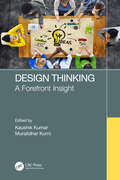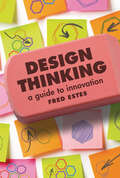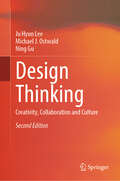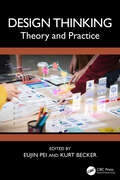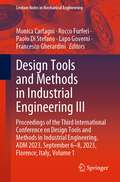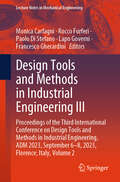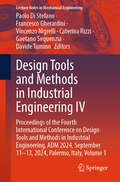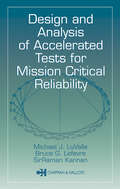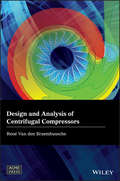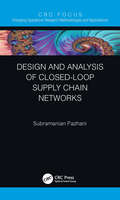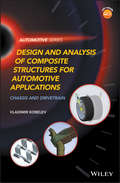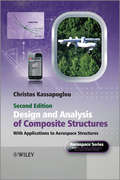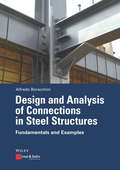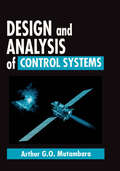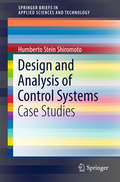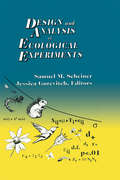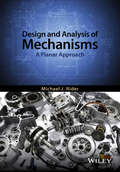- Table View
- List View
Design Thinking: A Forefront Insight
by Kaushik Kumar Muralidhar KurniDesign thinking is a ground-breaking problem solving process which combines logic, intuition, and systematic reasoning to develop long-term solutions to common engineering challenges and to inspire innovation. Serving as an introduction to the concept as well as a reference point, the book is essential reading for all engineers. Following a design thinking approach itself to structure its contents, this book is a key introduction to the process, providing case studies to demonstrate the multiple practical uses of the method. Relevant to sectors such as software development, Mobile App Development, sustainability and Artificial Intelligence, the book has a wide range of applications. The inclusion of a tools section to focus in on popular apps and software aids the reader in practically using the design thinking method. It ends by looking forward to the future prospects of design thinking, and the innovations which it can inspire. The book will be of interest to engineers of all professions, including design and management.
Design Thinking: A Guide to Innovation
by Fred EstesDesign thinking is a six-step process used in creative problem solving to understand users, challenge assumptions, redefine problems, and create innovative solutions. As a human-centered approach to innovation, design thinking is used in everything from corporate structure in businesses such as UberEATS, AirBnB, and Adobe XD to local and regional projects. Design Thinking, by author and educator Fred Estes, provides a simple, clear approach to the six-step design thinking process. This easy-to-follow guide explains everything essential to design thinking projects focused on solving human-centered, social issues. Readers will learn the fundamentals of each of the six-steps in the design thinking model—notice and reflect, empathize, define, ideate, prototype, and test—and discover how to collaborate with people to develop solutions to real-world problems and create better communities through creativity, inspiration, and teamwork. With true stories of real student teams and their projects, this book provides readers with the steps to effect change and create a more equitable world.
Design Thinking: Creativity, Collaboration and Culture
by Michael J. Ostwald Ning Gu Ju Hyun LeeThis book presents new ways of facilitating design thinking, through the combination of cognitive design strategies and information technologies. It provides readers with an in-depth understanding of the traditional and digital design processes and activities that are employed in architecture, computational design, communication design and graphic design. In response to evolving design practices, including the growing use of artificial intelligence (AI), this fully updated and expanded edition features a new chapter on digital design collaboration, along with extended discussions on the role of technology in shaping creative and collaborative processes. The book is divided into three parts: Part I, which focuses on creativity, uses evidence derived from empirical studies to develop an understanding of the way computational environments shape design thinking and may lead to more inventive outcomes. Part II considers the cognitive, sociotechnical dimensions of design teams, crowds and collectives. It investigates the ways digital design platforms promote interactive and collective thinking. Lastly, Part III addresses culture, examining the linguistic and cultural context of the globalised design ecosystem. Providing valuable insights into design thinking, this book helps readers engage with their local and global environments. It will appeal to academics, researchers and professionals with an interest in understanding design thinking in the context of creativity, collaboration and culture.
Design Thinking: Theory and Practice
by Kurt Becker Eujin PeiThis book aims to provide readers with an in-depth understanding of design thinking by documenting the personal insights of professionals and practitioners from a wide range of disciplines. Design Thinking: Theory and Practice refers to a series of cognitive, strategic, and practical steps used during the process of designing, and the context of how people reason when they engage with solving problems. The scope of this book focuses on topics such as problem-solving, systems thinking, innovation, and the role of design in product design and services. This book is unique as it brings together "stories" from both academics’ and practitioners’ perspectives, enabling readers to view design thinking from many different perspectives that can be applied in every-day life situations or for organizations when developing plans and policies. This book would be essential reading for design engineers, industrial designers, and mechanical engineers who have interest in design thinking.
Design Tools and Methods in Industrial Engineering II: Proceedings of the Second International Conference on Design Tools and Methods in Industrial Engineering, ADM 2021, September 9–10, 2021, Rome, Italy (Lecture Notes in Mechanical Engineering)
by Caterina Rizzi Francesco Gherardini Francesca Campana Michele Bici Tommaso Ingrassia Paolo CicconiThis book gathers original papers reporting on innovative methods and tools in design, modelling, simulation and optimization, and their applications in engineering design, manufacturing and other relevant industrial sectors. Topics span from advances in geometric modelling, applications of virtual reality, innovative strategies for product development and additive manufacturing, human factors and user-centered design, engineering design education and applications of engineering design methods in medical rehabilitation and cultural heritage. Chapters are based on contributions to the Second International Conference on Design Tools and Methods in Industrial Engineering, ADM 2021, held on September 9–10, 2021, in Rome, Italy, and organized by the Italian Association of Design Methods and Tools for Industrial Engineering, and Dipartimento di Ingegneria Meccanica e Aerospaziale of Sapienza Università di Roma, Italy. All in all, this book provides academics and professionals with a timely overview and extensive information on trends and technologies in industrial design and manufacturing.
Design Tools and Methods in Industrial Engineering III: Proceedings of the Third International Conference on Design Tools and Methods in Industrial Engineering, ADM 2023, September 6–8, 2023, Florence, Italy, Volume 1 (Lecture Notes in Mechanical Engineering)
by Francesco Gherardini Rocco Furferi Lapo Governi Paolo Di Stefano Monica CarfagniThis book gathers original peer-reviewed papers reporting on innovative methods and tools in design, modeling, simulation and optimization, and their applications in engineering design, manufacturing, and other relevant industrial sectors. Based on contributions to the Third International Conference on Design Tools and Methods in Industrial Engineering, ADM 2023, held on September 6–8, 2023, in Florence, Italy, and organized by the Italian Association of Design Methods and Tools for Industrial Engineering, and the Department of Industrial Engineering of the University of Florence, this first volume of a 2-volume set focuses on advances in design for additive manufacturing, engineering methods in medicine, user-centred design, and industrial design and ergonomics. Further topics include design for sustainability, engineering education, experimental methods for product development, and advanced methods for product and process design. This book provides academics and professionals with a timely overview and extensive information on trends and technologies in industrial design and manufacturing.
Design Tools and Methods in Industrial Engineering III: Proceedings of the Third International Conference on Design Tools and Methods in Industrial Engineering, ADM 2023, September 6–8, 2023, Florence, Italy, Volume 2 (Lecture Notes in Mechanical Engineering)
by Francesco Gherardini Rocco Furferi Lapo Governi Paolo Di Stefano Monica CarfagniThis book gathers original peer-reviewed papers reporting on innovative methods and tools in design, modeling, simulation and optimization, and their applications in engineering design, manufacturing, and other relevant industrial sectors. Based on contributions to the Third International Conference on Design Tools and Methods in Industrial Engineering, ADM 2023, held on September 6–8, 2023, in Florence, Italy, and organized by the Italian Association of Design Methods and Tools for Industrial Engineering, and the Department of Industrial Engineering of the University of Florence, this second volume of a 2-volume set focuses on interdisciplinary topics in design, such as human body acquisition and modelling, human factors and user-centered design, digital factories, and design methods for different engineering applications. All in all, this book provides academics and professionals with a timely overview and extensive information on trends and technologies in industrial design and manufacturing.
Design Tools and Methods in Industrial Engineering IV: Proceedings of the Fourth International Conference on Design Tools and Methods in Industrial Engineering, ADM 2024, September 11–13, 2024, Palermo, Italy, Volume 1 (Lecture Notes in Mechanical Engineering)
by Caterina Rizzi Vincenzo Nigrelli Francesco Gherardini Paolo Di Stefano Gaetano Sequenzia Davide TuminoThis book gathers original peer-reviewed papers reporting on innovative methods and tools in design, modeling, simulation and optimization, and their applications in engineering design, manufacturing, and other relevant industrial sectors. Based on contributions to the Fourth International Conference on Design Tools and Methods in Industrial Engineering, ADM 2024, held on September 11–13, 2024, in Palermo, Italy, and organized by the Italian Association of Design Methods and Tools for Industrial Engineering, and the Department of Engineering of the University of Palermo, this first volume of a 2-volume set focuses on advances in design for additive manufacturing, product design and engineering, design for sustainability and ecoDesign, experimental methods in product development and integrated methods for product and process design. Further topics include: simulation, analysis and optimization, design of collaborative and soft robots, geometrical product specification and tolerancing, and design methods for mobility. This book provides academics and professionals with a timely overview and extensive information on trends and technologies in industrial design and manufacturing.
Design Tools and Methods in Industrial Engineering IV: Proceedings of the Fourth International Conference on Design Tools and Methods in Industrial Engineering, ADM 2024, September 11–13, 2024, Palermo, Italy, Volume 2 (Lecture Notes in Mechanical Engineering)
by Caterina Rizzi Vincenzo Nigrelli Francesco Gherardini Paolo Di Stefano Gaetano Sequenzia Davide TuminoThis book gathers original peer-reviewed papers reporting on innovative methods and tools in design, modeling, simulation and optimization, and their applications in engineering design, manufacturing, and other relevant industrial sectors. Based on contributions to the Fourth International Conference on Design Tools and Methods in Industrial Engineering, ADM 2024, held on September 11–13, 2024, in Palermo, Italy, and organized by the Italian Association of Design Methods and Tools for Industrial Engineering, and the Department of Engineering of the University of Palermo, this second volume of a 2-volume set focuses on engineering methods in medicine, human factors and ergonomics, and reverse engineering. Further topics include: digital acquisition, image processing and inspection, virtual and augmented reality, virtual prototyping and digital twin, as well as engineering education, and knowledge and product data management. All in all, this book provides academics and professionals with a timely overview and extensive information on trends and technologies in industrial design and manufacturing.
Design Tools and Methods in Industrial Engineering: Proceedings of the International Conference on Design Tools and Methods in Industrial Engineering, ADM 2019, September 9–10, 2019, Modena, Italy (Lecture Notes in Mechanical Engineering)
by Caterina Rizzi Angelo Oreste Andrisano Francesco Leali Francesco Gherardini Fabio Pini Alberto VergnanoThis book reports on cutting-edge design methods and tools in industrial engineering, advanced findings in mechanics and material science, and relevant technological applications. Topics span from geometric modelling tools to applications of virtual/augmented reality, from interactive design to ergonomics, human factors research and reverse engineering. Further topics include integrated design and optimization methods, as well as experimental validation techniques for product, processes and systems development, such as additive manufacturing technologies. This book is based on the International Conference on Design Tools and Methods in Industrial Engineering, ADM 2019, held on September 9–10, 2019, in Modena, Italy, and organized by the Italian Association of Design Methods and Tools for Industrial Engineering, and the Department of Engineering “Enzo Ferrari” of the University of Modena and Reggio Emilia, Italy. It provides academics and professionals with a timely overview and extensive information on trends and technologies in industrial design and manufacturing.
Design and Analysis of Accelerated Tests for Mission Critical Reliability
by Michael J. LuValle Bruce G. LeFevre SirRaman KannanEarly approaches to accelerated testing were based on the assumption that there was a simple acceleration factor that would correspond to a linear scaling of time from the operating stress to the accelerating stress. This corresponds to the simplest physical model of the kinetics governing the underlying degradation, but this simple model does not
Design and Analysis of Biomolecular Circuits
by Douglas Densmore Heinz Koeppl Gianluca Setti Mario Di BernardoThe book deals with engineering aspects of the two emerging and intertwined fields of synthetic and systems biology. Both fields hold promise to revolutionize the way molecular biology research is done, the way today's drug discovery works and the way bio-engineering is done. Both fields stress the importance of building and characterizing small bio-molecular networks in order to synthesize incrementally and understand large complex networks inside living cells. Reminiscent of computer-aided design (CAD) of electronic circuits, abstraction is believed to be the key concept to achieve this goal. It allows hiding the overwhelming complexity of cellular processes by encapsulating network parts into abstract modules. This book provides a unique perspective on how concepts and methods from CAD of electronic circuits can be leveraged to overcome complexity barrier perceived in synthetic and systems biology.
Design and Analysis of Centrifugal Compressors (Wiley-ASME Press Series)
by Rene Van den BraembusscheA comprehensive overview of fluid dynamic models and experimental results that can help solve problems in centrifugal compressors and modern techniques for a more efficient aerodynamic design. Design and Analysis of Centrifugal Compressors isacomprehensive overview of the theoretical fluid dynamic models describing the flow in centrifugal compressors and the modern techniques for the design of more efficient centrifugal compressors. The author — a noted expert in the field, with over 40 years of experience — evaluates relevant numerical and analytical prediction models for centrifugal compressors with special attention to their accuracy and limitations. Relevant knowledge from the last century is linked with new insights obtained from modern CFD. Emphasis is to link the flow structure, performance and stability to the geometry of the different compressor components. Design and Analysis of Centrifugal Compressors is an accessible resource that combines theory with experimental data and previous research with recent developments in computational design and optimization. This important resource Covers the basic information concerning fluid dynamics that are specific for centrifugal compressors and clarifies the differences with axial compressors Provides an overview of performance prediction models previously developed in combination with extra results from research conducted by the author Describes helpful numerical and analytical models for the flow in the different components in relation to flow stability, operating range and performance Includes the fundamental information for the aerodynamic design of more efficient centrifugal compressors Explains the use of computational fluid dynamics (CFD) for the design and analysis of centrifugal compressors Written for engineers, researchers and designers in industry as well as for academics specializing in the field, Design and Analysis of Centrifugal Compressors offers an up to date overview of the information needed for the design of more effective centrifugal compressors.
Design and Analysis of Closed-Loop Supply Chain Networks (Emerging Operations Research Methodologies and Applications)
by Subramanian PazhaniClosed loop supply chains and their management have become mandatory for firms to stay competitive and profitable. This book provides insights into designing supply chain networks by understanding and incorporating key return parameters into the network design, which will affect profitability. The book discusses how customer categories and their acceptance behavior are incorporated into the network design. It also shows how to analyze the interaction of parameters on supply chain network design and profitability, offers modeling framework for incorporating uncertainties in the return product parameters, and shows how to design a robust network. Invaluable for managers in designing a sustainable, robust, and profitable supply chain network and ideal for managers, practitioners, and researchers in the area of supply chain network design and optimization.
Design and Analysis of Composite Structures for Automotive Applications: Chassis and Drivetrain (Automotive Series)
by Vladimir KobelevA design reference for engineers developing composite components for automotive chassis, suspension, and drivetrain applications This book provides a theoretical background for the development of elements of car suspensions. It begins with a description of the elastic-kinematics of the vehicle and closed form solutions for the vertical and lateral dynamics. It evaluates the vertical, lateral, and roll stiffness of the vehicle, and explains the necessity of the modelling of the vehicle stiffness. The composite materials for the suspension and powertrain design are discussed and their mechanical properties are provided. The book also looks at the basic principles for the design optimization using composite materials and mass reduction principles. Additionally, references and conclusions are presented in each chapter. Design and Analysis of Composite Structures for Automotive Applications: Chassis and Drivetrain offers complete coverage of chassis components made of composite materials and covers elastokinematics and component compliances of vehicles. It looks at parts made of composite materials such as stabilizer bars, wheels, half-axes, springs, and semi-trail axles. The book also provides information on leaf spring assembly for motor vehicles and motor vehicle springs comprising composite materials. Covers the basic principles for the design optimization using composite materials and mass reduction principles Evaluates the vertical, lateral, and roll stiffness of the vehicle, and explains the modelling of the vehicle stiffness Discusses the composite materials for the suspension and powertrain design Features closed form solutions of problems for car dynamics explained in details and illustrated pictorially Design and Analysis of Composite Structures for Automotive Applications: Chassis and Drivetrain is recommended primarily for engineers dealing with suspension design and development, and those who graduated from automotive or mechanical engineering courses in technical high school, or in other higher engineering schools.
Design and Analysis of Composite Structures: With Applications to Aerospace Structures (Aerospace Series)
by Christos KassapoglouNew edition updated with additional exercises and two new chapters. Design and Analysis of Composite Structures: With Applications to Aerospace Structures, 2nd Edition builds on the first edition and includes two new chapters on composite fittings and the design of a composite panel, as well additional exercises. The book enables graduate students and engineers to generate meaningful and robust designs of complex composite structures. A compilation of analysis and design methods for structural components made of advanced composites, it begins with simple parts such as skins and stiffeners and progresses through to applications such as entire components of fuselages and wings. It provides a link between theory and day-to-day design practice, using theory to derive solutions that are applicable to specific structures and structural details used in industry. Starting with the basic mathematical derivation followed by simplifications used in real-world design,Design and Analysis of Composite Structures: With Applications to Aerospace Structures, 2nd Edition presents the level of accuracy and range of applicability of each method along with design guidelines derived from experience combined with analysis. The author solves in detail examples taken from actual applications to show how the concepts can be applied, solving the same design problem with different methods based on different drivers (e.g. cost or weight) to show how the final configuration changes as the requirements and approach change. Each chapter is followed by exercises that represent specific design problems often encountered in the aerospace industry but which are also applicable in the in the automotive, marine, and construction industries. Updated to include additional exercises, that represent real design problems encountered in the aerospace industry, but which are also applicable in the in the automotive, marine, and construction industries. Includes two new chapters. One on composite fittings and another on application and the design of a composite panel. Provides a toolkit of analysis and design methods that enable engineers and graduate students to generate meaningful and robust designs of complex composite structures. Provides solutions that can be used in optimization schemes without having to run finite element models at each iteration; thus speeding up the design process and allowing the examination of many more alternatives than traditional approaches. Supported by a complete set of lecture slides and solutions to the exercises hosted on a companion website for instructors. An invaluable resource for Engineers and graduate students in aerospace engineering as well as Graduate students and engineers in mechanical, civil and marine engineering.
Design and Analysis of Connections in Steel Structures: Fundamentals and Examples
by Alfredo BoracchiniThe book introduces all the aspects needed for the safe and economic design and analysis of connections using bolted joints in steel structures. This is not treated according to any specific standard but making comparison among the different norms and methodologies used in the engineering practice, e.g. Eurocode, AISC, DIN, BS.Several examples are solved and illustrated in detail, giving the reader all the tools necessary to tackle also complex connection design problems. The book is introductory but also very helpful to advanced and specialist audiences because it covers a large variety of practice demands for connection design. Parts that are not taken to an advanced level are seismic design, welds, interaction with other materials (concrete, wood), and cold formed connections./p
Design and Analysis of Control Systems
by Arthur G.O. MutambaraWritten to inspire and cultivate the ability to design and analyze feasible control algorithms for a wide range of engineering applications, this comprehensive text covers the theoretical and practical principles involved in the design and analysis of control systems. From the development of the mathematical models for dynamic systems, the author shows how they are used to obtain system response and facilitate control, then addresses advanced topics, such as digital control systems, adaptive and robust control, and nonlinear control systems.
Design and Analysis of Control Systems
by Humberto Stein ShiromotoThis book provides methods to unify different approaches to tackle stability theory problems. In particular, it presents a methodology to blend approaches obtained from measure theory with methods obtained from Lyapunov's stability theory. The author summarizes recent works on how different analysis/design methods can be unified and employed for systems that do not belong to either of domains of validity.
Design and Analysis of Control Systems: Driving the Fourth Industrial Revolution
by Arthur G.O. MutambaraWritten to inspire and cultivate the ability to design and analyse feasible control algorithms for a wide range of engineering applications, this comprehensive text covers the theoretical and practical principles involved in the design and analysis of control systems. This second edition introduces 4IR adoption strategies for traditional intelligent control, including new techniques of implementing control systems. It provides improved coverage of the characteristics of feedback control, root-locus analysis, frequency-response analysis, state space methods, digital control systems and advanced controls, including updated worked examples and problems.Features: Describes very timely applications and contains a good mix of theory, application, and computer simulation. Covers all the fundamentals of control systems. Takes a transdisciplinary and cross-disciplinary approach. Explores updates for 4IR (Industry 4.0) and includes better experiments and illustrations for nonlinear control systems. Includes homework problems, case studies, examples, and a solutions manual. This book is aimed at senior undergraduate and graduate students, professional engineers and academic researchers, in interrelated engineering disciplines such as electrical, mechanical, aerospace, mechatronics, robotics and other AI-based systems.
Design and Analysis of Distributed Energy Management Systems: Integration of EMS, EV, and ICT (Power Electronics and Power Systems)
by Anh Tuan Tran Tatsuya Suzuki Shinkichi Inagaki Yoshihiko SusukiThis book provides key ideas for the design and analysis of complex energy management systems (EMS) for distributed power networks. Future distributed power networks will have strong coupling with (electrified) mobility and information-communication technology (ICT) and this book addresses recent challenges for electric vehicles in the EMS, and how to synthesize the distributed power network using ICT. This book not only describes theoretical developments but also shows many applications using test beds and provides an overview of cutting edge technologies by leading researchers in their corresponding fields. Describes design and analysis of energy management systems;Illustrates the synthesis of distributed energy management systems based on aggregation of local agents;Discusses dependability issues of the distributed EMS with emphasis on the verification scheme based on remote-operational hardware-in-the-loop (HIL) simulation and cybersecurity.
Design and Analysis of Ecological Experiments
by Sam ScheinerThe goal of this book is to make some underutilized but potentially very useful methods in experimental design and analysis available to ecologists, and to encourage better use of standard statistical techniques. Ecology has become more and more an experimental science in both basic and applied work,but experiments in the field and in the laboratory often present formidable statistical difficulties. Organized around providing solutions to ecological problems, this book offers ways to improve the statistical aspects of conducting manipulative ecological experiments, from setting them up to interpreting and reporting the results. An abundance of tools, including advanced approaches, are made available to ecologists in step-by-step examples, with computer code provided for common statistical packages. This is an essential how-to guide for the working ecologist and for graduate students preparing for research and teaching careers in the field of ecology.
Design and Analysis of Functionally Graded Adhesively Bonded Joints of FRP Composites
by Sashi Kanta Panigrahi Sunil V. NimjeThis book provides up-to-date information relevant to the analysis and design of adhesively bonded joints made up of fiber-reinforced polymer (FRP) composites using functionally graded adhesive (FGA). Damage behaviors in adhesively bonded joints of laminated FRP composites have been addressed, and joint configurations have been modeled using special finite elements (FEs) and multipoint constraint elements to simulate the contact behavior. Detailed 3D finite element analyses (FEAs) have been presented for different adhesively bonded joint structures along with guidelines for effective design philosophy of adhesively bonded joints in laminated FRP structures using FGA. Features: Provides a thorough and systematic discussion on the functionally graded adhesive and its joints. Discusses analytical modeling and numerical analyses of the joints. Details 3D stress and failure delamination analysis for composite analyses of functionally graded out-of-plane joints under various combinations of loading. Illustrates FE modeling and simulation of interfacial failure and damage propagation in out-of-plane joints. Includes the effect of various gradation function profiles on damage growth driving forces (SERR). This book is aimed at researchers, professionals and graduate students in composites, infrastructure engineering, bonding technology and mechanical/aerospace engineering.
Design and Analysis of Materials and Engineering Structures
by Andreas Öchsner Lucas F. Silva Holm AltenbachThe idea of this monograph is to present the latest results related to design and analysis of materials and engineering structures. The contributions cover the field of mechanical and civil engineering, ranging from automotive to dam design, transmission towers and up to machine design and exmaples taken from oil industry. Well known experts present their research on damage and fracture of material and structures, materials modelling and evaluation up to image processing and visualization for advanced analyses and evaluation
Design and Analysis of Mechanisms
by Michael RiderA planar or two-dimensional (2D) mechanism is the combination of two or more machine elements that are designed to convey a force or motion across parallel planes. For any mechanical engineer, young or old, an understanding of planar mechanism design is fundamental. Mechanical components and complex machines, such as engines or robots, are often designed and conceptualised in 2D before being extended into 3D. Designed to encourage a clear understanding of the nature and design of planar mechanisms, this book favours a frank and straightforward approach to teaching the basics of planar mechanism design and the theory of machines with fully worked examples throughout. Key Features: Provides simple instruction in the design and analysis of planar mechanisms, enabling the student to easily navigate the text and find the desired material Covers topics of fundamental importance to mechanical engineering, from planar mechanism kinematics, 2D linkage analyses and 2D linkage design to the fundamentals of spur gears and cam design Shows numerous example solutions using EES (Engineering Equation Solver) and MATLAB software, with appendices dedicated to explaining the use of both computer tools Follows end-of-chapter problems with clearly detailed solutions
